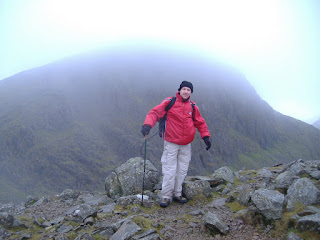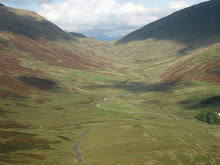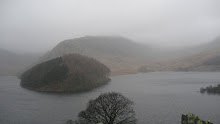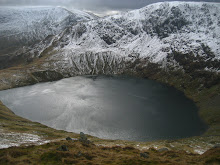
This last week I have been up in England's Lake District in the county of Cumbria. Cumbria , situated in the north west is England's most mountainous county filled
with wonderful peaks with names suchas Haystacks, Pillar and Hellvelyn to mention but a few, They are not mountains on the scale of the Himalaya's or Southern Alps but non the less in my opinion they are just as beautiful,if not more so. There is so much history to be found in these English mountains from shepherds and their flocks to slate miners. This week I went to climb a mountain known simply as 'High Street' in the vicinity of Haweswater. The name High Street does not imply that you will find a butchers or bakers on the summit rather it takes you back to the day when it's summit was a high up Roman road linking their garrisons at Ambleside and Brougham and on the south side of the mountain lies the Troutbeck slopes where Scotch invaders were repulsed by the shepherds, dalesmen and farmers whom made the summit their playground and feasting place during their annual horse racing meets. I made my ascent via Rough Crag which at first is a pleasant climb with the odd scramble thrown in to get your hands dirty however the English weather was quite bad at the time with high winds from the Atlantic buffeting us as we ventured into exposed area's. We made it into the snow about half way up Long Stile which is around 100 yards from the top but due to the severe winds in this unsheltered area we decided to come back down via Blea tarn. No sooner had we turned back when the summit became a white out with a snow storm coming in from the south. The climb down via Blea Tarn leads one to a lovely body of water with a small dam surrounded by the mountain, and a gentle walk down to Haweswater following Blea Water Beck through gorgeous coloured fells with a number of waterfalls thrown in to impress. If your interested in this part of England may I recomend the books of A Wainwright or the DVD's of Wainwright's walks presented by Julia Bradbury.



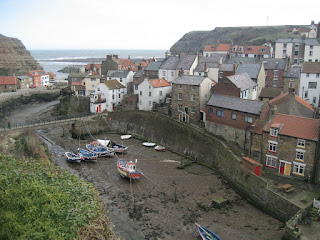 Recently I visited the small hamlet of Staithes on the Cleveland/North Yorkshire border and what a day to visit. It was during a period when little old England was getting hammered by strong winds from the Atlantic, however the wind kind of enhanced my visit and added to the enjoyment of being there especially with regard to the waves that the North Sea was sending against the rocks and breakwater of Staithes harbour. Staithes is a seaside village which is divided between Yorkshire & Cleveland by Roxby Beck with about 90% of Staithes being in North Yorkshire. In times past it was one of the largest and most productive fishing centres in England by the North Sea, however nowadays it is largely a tourist destination due to it's attractive olde England appearance. Staithes is noted for its sheltered harbour, bounded by high cliffs and two long breakwaters, a mile to the north is Boulby cliff which is the highest cliff in England. The cliffs around Staithes also are popular with sea birds and it can get a bit noisy. Staithes population has dwindled due to a lot of the cottages being owned by people from Leeds and York for example and during the winter it can appear like a ghost town with few visitors but this is a great time to visit if you can handle the stormy weather. Staithes still maintains its tradition and many of the local women still wear their Staithes bonnets (some can still be bought today in the Gift Shop in Staithes!) for the annual nightgown parade, and the Fisher Men's choir is still going strong along with local participation in the local RNLI Lifeboat. In 1745-1746, Staithes's most famous son (born in Marton near Middlesbrough), the young James Cook worked in Staithes as a grocer's apprentice where he first gained his passion for the sea. Later he moved to Whitby where he joined the Royal Navy. William Sanderson's shop, where Cooky worked, was destroyed by the sea, but parts were recovered and incorporated into "Captain Cook's Cottage". A local family has lived here for a number of generations. Should you find yourself in Staithes make sure you visit the Royal George or the Cod & Lobster for a pint of the local and a bite to eat. One last thing Staithes is famous for , it has the most dangerous car park in England as can be seen by my picture. When I was there a local resident by the name of Sandra climbed down to investigate this strange sight. ( I suspect she's a menber of the Royal Marines Reserve but the secret is out now)
Recently I visited the small hamlet of Staithes on the Cleveland/North Yorkshire border and what a day to visit. It was during a period when little old England was getting hammered by strong winds from the Atlantic, however the wind kind of enhanced my visit and added to the enjoyment of being there especially with regard to the waves that the North Sea was sending against the rocks and breakwater of Staithes harbour. Staithes is a seaside village which is divided between Yorkshire & Cleveland by Roxby Beck with about 90% of Staithes being in North Yorkshire. In times past it was one of the largest and most productive fishing centres in England by the North Sea, however nowadays it is largely a tourist destination due to it's attractive olde England appearance. Staithes is noted for its sheltered harbour, bounded by high cliffs and two long breakwaters, a mile to the north is Boulby cliff which is the highest cliff in England. The cliffs around Staithes also are popular with sea birds and it can get a bit noisy. Staithes population has dwindled due to a lot of the cottages being owned by people from Leeds and York for example and during the winter it can appear like a ghost town with few visitors but this is a great time to visit if you can handle the stormy weather. Staithes still maintains its tradition and many of the local women still wear their Staithes bonnets (some can still be bought today in the Gift Shop in Staithes!) for the annual nightgown parade, and the Fisher Men's choir is still going strong along with local participation in the local RNLI Lifeboat. In 1745-1746, Staithes's most famous son (born in Marton near Middlesbrough), the young James Cook worked in Staithes as a grocer's apprentice where he first gained his passion for the sea. Later he moved to Whitby where he joined the Royal Navy. William Sanderson's shop, where Cooky worked, was destroyed by the sea, but parts were recovered and incorporated into "Captain Cook's Cottage". A local family has lived here for a number of generations. Should you find yourself in Staithes make sure you visit the Royal George or the Cod & Lobster for a pint of the local and a bite to eat. One last thing Staithes is famous for , it has the most dangerous car park in England as can be seen by my picture. When I was there a local resident by the name of Sandra climbed down to investigate this strange sight. ( I suspect she's a menber of the Royal Marines Reserve but the secret is out now) 


